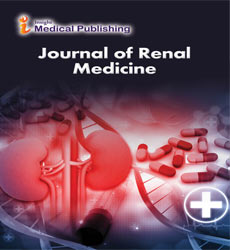Impact of Socioeconomic Status on Pediatric Chronic Kidney Disease Outcomes and Care Access
Kelly Aaron*
Department of Nephrology, University of Wisconsin School of Medicine and Public Health, Madison, USA
- *Corresponding Author:
- Kelly Aaron
Department of Nephrology, University of Wisconsin School of Medicine and Public Health, Madison,
USA,
E-mail: aronk@yahoo.com
Received date: June 17, 2024, Manuscript No. IPJRM-24-19503; Editor assigned date: June 20, 2024, PreQC No. IPJRM-24-19503 (PQ); Reviewed date: July 04, 2024, QC No. IPJRM-24-19503; Revised date: July 11, 2024, Manuscript No. IPJRM-24-19503 (R); Published date: July 18, 2024, DOI: 10.36648/ipjrm.7.4.36
Citation: Aaron K (2024) Impact of Socioeconom ic Status on Pediatric Chronic Kidney Disease Outcomes and Care A ccess. J R en Med V ol.7 No.4: 36.
Description
Chronic Kindy Disease (CKD) is a rare but devastating condition that affects children. Adults with lower socioeconomic status bear the brunt of CKD more heavily, with a higher prevalence of advanced CKD and kidney failure, lower access to KRT and worse outcomes. Lower financial status in major league salary nations like Joined Realm and social determinants of wellbeing, for example, health care coverage inclusion and schooling level have been related with an expanded predominance of CKD. A higher risk of adult acute kidney injury was also linked to social exclusion. In the pediatric populace, given the age explicit dispersion of reasons for CKD, we could expect that the climate makes a restricted difference though hereditary determinants strongerly affect the frequency of kidney disappointment.
Pediatric Chronic Kindy Disease (CKD)
Recommended that financial contrasts create risk factors related with the turn of events and movement of pediatric CKD, found a rough relationship between neighborhood neediness and movement to kidney disappointment in US youngsters and a relationship with hospitalizations and crisis division use after change. This is in line with our two most recent studies, which found that a validated ecological EDI was associated with KRT modality, urgent-start of KRT and graft survival in metropolitan France, 40% of children start KRT. We hypothesize that social exclusion is also linked to the development of CKD at earlier stages and consequently, to the incidence of kidney failure in children. However, no study to our knowledge has examined whether the prevalence of KRT in children varies with social deprivation, particularly in nations where equal access to care is intended. Consequently, our objective was to estimate and compare the prevalence of pediatric KRT based on social deprivation in metropolitan France, one of the organization for economic cooperation's member countries and development's countries with the lowest out-of-pocket costs for chronic diseases and where universal health insurance covers 100% of CKD costs. The quintile of EDI assigned to each IRIS served as the basis for our description of the geographical distribution of poverty. On a different metropolitan map, we were represented.
Pediatric nephrology
Hematuria is a typical tracking down in pediatric patients with problems of the urinary and renal frameworks. Despite the fact that hematuria is a typical harmless side effect, there is a critical expanded chance of movement to kidney disappointment. As a result, the root cause of hematuria in children should be investigated. Different causes can prompt hematuria in youngsters, for example, urologic parcel sickness, interstitial and rounded illnesses, glomerular sicknesses including issues of the Glomerular Basement Membrane (GBM), hematologic irregularities and others. GBM, as a specific type of extracellular network, formed a boundary to hinder red platelets from entering the pee. Microscopic hematuria may result from abnormal changes in the GBM. Other molecules of glycoproteins are bound to the type IV collagen. GBM layering or thinning is the most common cause of glomerular hematuria, which is frequently brought on by germline variants of the COL4A3, COL4A4, or COL4A5 genes. AS and meager storm cellar layer nephropathy are the two infection substances connected with the above quality variations, which can be analyzed by kidney biopsy or hereditary test. Genetic testing is less invasive than kidney biopsy, which is especially important for pediatric patients. In addition, for AS, the significant prerequisite for the ideal administration is to make early determination. Because layering of GBMs, the typical AS findings, can generally be observed at later stages and frequently only show thinning of GBM in female X-Linked AS (XLAS) and Autosomal Dominant AS (ADAS) cases, genetic tests are of great value for diagnosing AS. In addition, hereditary test likewise has benefits for possibly impacted relatives, which maintains a strategic distance from the requirement for kidney biopsy and permits early determination and treatment. WES is a broad testing approach and specifically successions the proteincoding locales of the genome, which can recognize most quality variations related with hematuria. In addition, it may be able to uncover novel hematuria-causing gene variants, enriching the disease-associated variants. Additionally, WES may uncover accidental mutations unrelated to the primary testing indications. Because of these factors, WES is gaining popularity as a preferred method of diagnosing hereditary renal and urinary disorders.
Open Access Journals
- Aquaculture & Veterinary Science
- Chemistry & Chemical Sciences
- Clinical Sciences
- Engineering
- General Science
- Genetics & Molecular Biology
- Health Care & Nursing
- Immunology & Microbiology
- Materials Science
- Mathematics & Physics
- Medical Sciences
- Neurology & Psychiatry
- Oncology & Cancer Science
- Pharmaceutical Sciences
